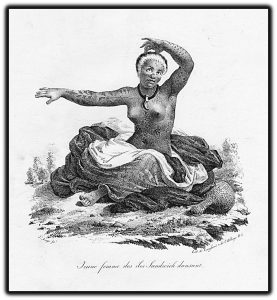Jeune femme des Iles Sandwich dansant, 1822, Jacques Arago (1770 – 1855)
Kuini Liliha, this 17 year old hula dancer, an ali’i, a noble woman of O’ahu Island, was depicted by Jacques Arago in 1819 dancing the sitting hula. Hula, of course, was also performed standing – one way or the other, the dance would express, often with overt lasciviousness, the spoken word in gesture, posture and body movement set to song or chant. The modern version of hula is somewhat less explicit.
Kuini Liliha’s front tooth had been knocked out with a rock in mourning for her King. Her short haired fringe, hands and face bleached white with burnt coral lime.
***
That hoary old sea-grizzled Captain James Cook of Whitby, all of 50, was easily tempted out of a short and uneasy retirement by the promise of a measly prize of five and a half million pounds.
Secretly, Cook had been engaged by the Admiralty to identify the elusive and possibly invaluable Northwest Passage between the Pacific and Atlantic Oceans. Publicly, it was made known that Cook was to sail 17,500 miles to deliver the gift-laden superstar Omai back to the Leeward island of Huahine.
Uncommonly “tall and handsome”, as my Granny would say, the inherently charismatic intelligent Omai, the “noble savage” born in Tahiti, had been brought to England by Cook on his first round the world expedition in 1768. Carefully selected, this first ever Polynesian visitor to England had enchanted London society, had been received by King George III (“How do, King Tosh”), and had been painted by genius Joshua Reynolds.
Above all was the public’s total fascination with Omai’s tatau. All sailors since Cook’s have carried his “tattoos”.
On the tedious search of the far north Pacific, intense cold and stray ice flows had caused the crews of HMS Resolution and HMS Discovery to threaten mutiny. On retracing his route to find some degree of warmth, Cook, now in the most remote location on earth, stumbled upon balmy Na Moku o Hawai’i.
The lush volcanic archipelago of eight islands and 129 mini atolls and islets was spattered across 1500 miles of ocean – California 2400 miles away, Japan 3850 miles in the opposite direction. The largest volcano was considerably higher than Mount Everest – 13,796 feet above the sea, 19,700 feet beneath the sea.
Cook leant his spectacular find his sponsor’s name – The Sandwich Islands. The 4th Earl of Sandwich was, after all, the First Lord of the Admiralty and The Prize was within his gift.
On 17 January 1779, after some considerable hesitation, Cook decided to anchor for the winter at Kealakekua Bay on the island of Hawai’i – “The Big Island” – 93 miles long.
The inhabitants were ecstatic. By sheer chance, Cook had made land during the important festival in honour of their revered god, Lono. The propitious arrival of two enormous sailing ships filled with their very first view of 180 midget white men was a miraculous phenomenon. The suddenly deified leader Captain Cook was immediately tacked on to their essential pantheon.
The average European military man of the time was a puny 5’5” tall. The Hawaiian men were similar to Omai – pleasing bronze complexion, extravagantly tattooed, average height 5’10” rising to 6’7”, robust but not obese – the women similar and occasionally taller, equally attractive and notoriously provocative. The “big bodies” were attributed to intensely selective breeding and an equally picky high fish protein and fruit and vegetable diet – along with a lot of hard physical work.
Cook was only too well aware of the presence of venereal diseases in his crews. He forbad the super-eager local girls access to his ships, but nevertheless they swarmed over them, so utterly delighted with this irresistible novelty.
As noted by his crews, Cook himself had become distrait and distracted – unusually cruel, lacking his usual tact, poor decision making, sometimes irrational. Having been seen as a god was unfortunate. His crew’s unrestrained relationships with the willing women, the over-generosity of the gullible population, an excess of strong spirits, and eventually the destruction of a reverenced temple for firewood and the theft of a valuable ship’s cutter, all and more lead to an inevitable hiatus.
Cook, with an escort of marines, set off inland to meet with the local chief. He failed to find him, retired to the beach where a turbulent crowd had gathered, his panicky little escort started to fire without orders, Cook turned to shout at them to stop, and was stabbed in the back.
As simple as that.
***
Cook’s unforeseen pitfall in Hawai’i had been kapu, the unique and exacting order of behaviour which had remained undisturbed for at least two thousand years. Despite his previous record of insightfulness, Cook had failed to appreciate, most probably through lack of a common language, the niceties, the nuances and the particular rigours of this strange rule of law.
Across the water, America had been gathering self-confidence following its independence. Also, ever-ambitious English missionaries had seen their chance. Hawai’i was quickly beset with do-gooders and chancers, changing its cherished way of life for keeps.
***
Since Cook, there had been a brief brisk war between the islands resulting in their amalgamation into a single sovereign kingdom under Hawaiian rule, and, on the death of King Kamehameha, the “breaking”, the dissolution, of kapu in 1819. His successor, King Kamehameha II, was a vigorously over-enthusiastic 22 year old who had formed a notion that English democracy would be an ideal political system for his new kingdom. Ignoring all wiser opinion, he chartered the whaler “L’Aigle” under Captain Valentine Starbuck, and set off on the 17,500 mile sail to seek the guidance and protection of King George IV.
The Hawaiian King with his favourite six foot wife (he had five to choose from), Queen Kamamalu, took an entourage of at least nine (not including servants) on his round the world drop-in – including, of course, High Chief Boki and his wife, the outstandingly attractive hula dancer, High Chiefess Kuini Liliha.
The royal party from The Sandwich Islands, somewhat inappropriately underdressed for the occasion when landing at Portsmouth in 1824, was greeted with huge curiosity by Londoners. Staying at the smart Osborn’s Hotel, Aldwych, the enormous crowds rapidly grew rougher and rowdier, egged on by frequent appearances at windows to wave.
These Islanders are of a very large size. The men appear to be above six feet tall, and exceedingly stout. The females are equally fat and coarse made, and proportionably taller than the men. The whole party are of the darkest copper colour, very nearly approaching to black, reported The Times to its readers.
A rabble of open-mouthed curious-coloured Royalty – to the very great annoyance of the customers of the house, the injury of its business, and the scandal of the whole neighbourhood, complained the owner of Osborn’s Hotel to the local magistrate.
Somewhat non-plussed, King George hesitated to allow these weird and wonderful savages to be presented at court. Frederick “Poodle” Byng, a Gentleman Usher of the Privy Chamber (yes!), was appointed to dress the islanders appropriately, to indicate how to behave decently, and to amuse them – all of which tasks he performed to perfection.
A large reception and a tour of London with a visit to Westminster Abbey, many of the entourage painted by the Hayter family, visits to the Royal Opera House and the Theatre Royal Drury Lane – all went well, and the date was fixed for a meeting with King George on 21 June 1824.
On 5 June, the Hawaiian court visited the Royal Military Asylum at Chelsea, a school founded in 1803 to educate the orphans of British serviceman killed in the Napoleonic Wars. Being totally non-immune, all members of the court contracted measles. Many died, including Queen Kamamalu on 8 July 1824 and King Kamehameha II, “grief-stricken”, on 14 July 1824.
***
High Chief Boki, the husband of the hula dancer High Chiefess Kuini Liliha, finally had an audience with King George. The Kingdom of Hawaii became a British protectorate. The Hawaiian state flag has eight alternating red, white and blue stripes representing the eight Sandwich Islands, along with the Union Jack in the top corner.
***
Despite all his best efforts, Cook left terrible retribution. Obviously, the totally isolated islanders had had no immunity to any of our native diseases – that long drear list of viral and bacterial afflictions which had kept our own population under severe control. From syphilis and gonorrhoea through a fatal catalogue to leprosy and tuberculosis, the islanders suffered every single one, in wave upon wave of epidemics as more and more foreign visitors arrived. The highly infectious measles had been particularly lethal.
The population of the Sandwich Islands in Cook’s day has been estimated at between four and seven hundred thousand. From 1778 to 1840, the population had declined by 84% to around 109,000. The Hawaiian government census of 1872 revealed a flimsy total of 56,897 inhabitants.
***
In 2000 it was declared that measles had been eradicated in America. By 2017, the UK had caught up. Small outbreaks have come and gone unremarked. During the year 2023, 368 cases had been confirmed in the UK, having risen sharply by 157 cases in December (gov.uk). In January 2024, 127 cases were confirmed, mainly in the West Midlands (gov.uk) NHS figures show that more than 3.4 million children under the age of 16 years are unprotected by the MMR vaccine (Maria Caulfield, Under-Secretary for Health and Social Care, January 2024).
The blame has been ascribed to COVID shut downs by our Government, and, perhaps, parental vaccine aversion. There has been no mention of the very many millions of zero-dose and under-vaccinated children in the Middle East and North African (MENA) regions (UNICEF, 27 April 2023), let alone all the other low-income countries with significant measles outbreaks (CDC, 12 February 2024). These children and unvaccinated adults will have been well represented in the tsunami of immigrants entering the UK of late.
The provisional estimates of total long-term immigration for year ending June 2023 was 1.2 million (ONS.gov.uk)
Richard Petty




